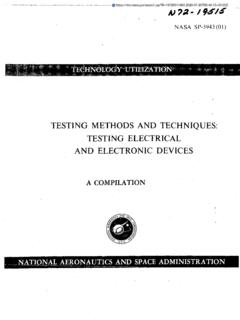Transcription of Multilayer Insulation Material Guidelines - NASA
1 2020-06-24T05:20:30+00:00Z. NASA/TP--1999-209263. Multilayer Insulation Material Guidelines Finckenor Marshall Space Flight Center, Marshall Space Flight Center, Alabama D. Dooling D 2 Associates, Huntsville, Alabama National Aeronautics and Space Administration Marshall Space Flight Center MSFC, Alabama 35812. April 1999. Trade Names Trade names are used in this guidebook to illustrate the use of various commercial materials and not to imply endorsement by the Government. The trade names are the property of the companies listed here. Trade names should be used only to describe specific products, not as generic terms (for example, not all hook-and-pile fasteners are Velcro brand). 3M Co.: Nextel, Scotch Chemfab: Beta cloth Dupont de Nemours Inc.: Dacron, Kapton, Kevlar, Mylar, Nomex, Nylon, Tedlar, Teflon Kamen Wiping Materials, Inc.: Rymple cloth Texwipe Co.: Alpha 10 wipe Velcro USA, Inc.: Velcro, Hi-Garde Available from: NASA Center for AeroSpace Information National Technical Information Service 800 Elkfidge Landing Road 5285 Port Royal Road Linthicum Heights, MD 21090-2934 Springfield, VA 22161.
2 (301) 621-0390 (703) 487-4650. ii TABLE OF CONTENTS. 1. INTRODUCTION .. Scope .. 2. Purpose .. 2. Applicability .. 4. 2. APPLICABLE DOCUMENTS .. 5. NASA .. 5. Department of Defense .. 5. Other Government .. 5. Other .. 6. 3. Guidelines .. 7. Applicable Documents .. Processing .. Materials Traceability .. 4. SELECTION OF MATERIALS .. Standard Blanket Layers .. 9. Thread Selection .. 14. Adhesives .. 15. Adhesive Tape .. 16. Fasteners .. 18. 5. FINISHING .. 22. Seams .. 22. Billowing .. 23. Tie Downs .. 23. 6. ENVIRONMENTAL EFFECTS ON Multilayer Insulation .. 24. Atomic Oxygen .. 24. Ultraviolet Radiation .. 25. Meteoroid/Orbital Debris Impacts .. 25. Contamination Control .. 27. Outgassing .. 27. Plasma Effects .. 27. iii TABLE OF CONTENTS (Continued). 7. OTHER CONCERNS .. 28. Electrical Bonding and Grounding .. 28. Installation Requirements .. 28. Venting Requirements .. 29. Cutouts or Protrusions .. 30. 30. Storage .. 30. Repair .. Other Hazards .. 31. Cryogenic Insulation .. 31. 8.
3 VENDORS .. 32. iv LIST OF FIGURES.. Schematic cross section depicts the key elements of an MLI blanket. Not all elements need be present in every design .. The interior of Space Shuttle Columbia's payload bay is seen here with the Spacelab module (right) and crew transfer tunnel (left to center) installed before the vehicle is closed and moved for stacking. Note that virtually everything inside is covered in Beta cloth since the Shuttle orbiter flies, for up to 2 wk at a time, with the payload bay doors open .. 2.. Experiment trays on the LDEF showed varying degrees of damage, depending on their orientation relative to the line of flight, after 69 mo in orbit .. 3.. MLI is fragile and easily damaged even under controlled conditions. The MLI. covering the Huygens Titan probe was damaged by cooling air that was blown too quickly through the launch vehicle nose fairing. The probe had to be removed so the MLI could be repaired .. 4.. (a) A technician checks the thickness of MLI components as they are assembled into a complete blanket assembly.
4 Note that she is wearing latex gloves, a hair cover, and safety glasses. T-shaped objects to the rear are large plastic clips (the same as for potato chip bags) to gently hold MLI sets together. Also note that blanket materials farther back on the table are covered with bagging plastic. (b) Two technicians, also wearing gloves and face masks, hold a completed blanket. It includes hook-and-pile fastener strips at top and right, and a neatly stitched cutout strip, from the left side, for a protrusion (Boeing photos) .. Several reflectors' layers are stitched to make a complete blanket (photo courtesy of Boeing) .. 22. , AO erosion is readily seen in scanning electron microscope images. Beta cloth (a) before and (b) after exposure to AO. Note that the Teflon coating has been eroded but that the glass fibers remain intact. Samples of (c) Kapton and (d) silverized Teflon are shown after exposure to AO on LDEE .. 24.. Multilayer Insulation is easily penetrated by high-speed debris, as in this ballistic test of a panel using a sample of Space Station materials.
5 Lightweight, slower debris poses a greater hazard to MLI which can erode with long exposure, especially when coupled with AO and UV effects. These views cover a width of _-15 cm (6 in.) .. 25. V. LIST OF FIGURES (Continued). , To protect areas where the MLI had degraded in orbit (a), astronauts applied MLI repair patches (b) to the exterior of the Hubble Space Telescope (c) during the January 1997. servicing mission (STS-82). Such repair techniques will become more common with expanded operation of long-duration spacecraft and the availability of humans or robots to maintain them .. 26. 10. Electrical grounding straps are required to ground MLI layers to the primary structure on spacecraft that may build up a static charge. In this design for the International Space Station, the aluminized polyimide layers are electrically connected by aluminum foil (the grounding insert), and a metal grommet through the blanket connects the layers to the ground strap (from a Boeing drawing) .. 29.
6 11. Beta cloth-covered MLI in the aft end of the Space Shuttle payload bay was pulled out of position by the payload bay door mechanism. The underlying spacecraft structure was not damaged, but the event highlights the potential for damage with moving equipment .. 31. vi LIST OF TABLES. o Standard blanket layers, outer cover .. 10. 2. Reflector layers .. 11. 3. Separator layers .. 12. 4. Reinforced Kapton inner cover .. 13. 5. Reinforced multilaminate inner cover .. 13. 6. Threads for nonexposed MLI seams .. 14. 7. Threads for exposed MLI seams .. 15. 8. PSA tape, plain .. 16. 9. PSA tape, glass fabric .. 17. 10. PSA tape, metallized .. 17. 11. Conductive tape .. 18. 12. Organic hook-and-pile fasteners .. 19. 13. Metallic hook-and-pile fasteners .. 20. 14. Lacing tapes and tie cords .. 21. vii LIST OF ACRONYMS. AO Atomic oxygen BOL Beginning of life EOIM Evaluation of Oxygen Interaction with Materials EOL End of life GSFC Goddard Space Flight Center HST Hubble Space Telescope ISS International Space Station JSC Johnson Space Center LDEF Long-Duration Exposure Facility LEO Low-Earth orbit MDAC McDonnell Douglas Aerospace Company (now part of Boeing Co.)
7 M&P Materials and Processes MLI Multilayer Insulation MSFC Marshall Space Flight Center MUA Materials Usage Agreement NASA National Aeronautics and Space Administration PTFE Polytetrafluoroethylene SSF Space Station Freedom (now ISS). STM Standard Material specification STP Standard processing specification UV Ultraviolet ix TECHNICAL PUBLICATION. Multilayer Insulation Material Guidelines . 1. INTRODUCTION. In general, Multilayer Insulation (MLI) is a type of high-performance insulator which uses multiple radiation-heat transfer barriers to retard the flow of energy. Individual radiation barriers usually are thin polymer films with vapor-deposited metal on one or both sides. Because it is nearly impossible to design a blanket that reflects 100 percent of incident radiation, an MLI design may range from a few simple blankets to a series of subblankets to fit complex geometries (fig. 1). Typically, each reflector will reflect 90 to 99. percent of radiation. The cumulative effect is that of a nearly 100-percent-effective barrier.
8 For MLI to be effective, a number of Guidelines must be followed in selecting materials, designing them into the spacecraft, and assembling the vehicle. TypicalMultilayerInsulationStackingArran gement (Sectionof book in parentheses). / _ I. Outer Cover ( ) ". Light Block(if necessary). MetallizedReflector( ) [. Netting Spacer ( ). /. ExposedThreads ( ) AdhesiveTransferTape ( ) Glass FabricTape ( ). Nonexposed Threads ( ). (15 to 20 Reflector/SpacerLayers,Total) Adhesives( ) MetallizedTape( ). Hook-and-Pile GroundingTape ( ). Connectors ( ). MetallizedSeflector ( ). Netting Spacer ( ) I. InnerCover ( ). Structure Note: Detailsand featuresareshown for illustrationand will varywith actual designand installation. Figure 1. Schematic cross section depicts the key elements of an MLI blanket. Not all elements need be present in every design. Scope This document defines the materials approved for and used in previous spacecraft thermal blanket designs. Data from these can be used for future MLI designs on various spacecraft surfaces, whether exposed to the space environment or shielded from direct exposure.]
9 Some Material data gathered from ground simulations of the space environment are included. Purpose The purpose of this document is to provide data on MLI materials used by previous spacecraft such as Spacelab (fig. 2) and the Long-Duration Exposure Facility (LDEF) (fig. 3), and outlines other concerns (fig. 4). The data within this document are presented for information only. They can be used as Guidelines for MLI design for future spacecraft provided the thermal requirements of each new design and the environmental effects on these materials are taken into account. Figure 2. The interior of Space Shuttle Columbia's payload bay is seen here with the Spacelab module (right) and crew transfer tunnel (left to center) installed before the vehicle is closed and moved for stacking. Note that virtually everything inside is covered in Beta cloth since the Shuttle orbiter flies, for up to 2 wk at a time, with the payload bay doors open. 2. Figure3. Experimenttrayson the LDEF showedvaryingdegreesof damage, dependingon their orientation relative to the line of flight, after 69 mo in orbit.
10 Figure4. MLI is fragile and easily damagedeven undercontrolled conditions. The MLI. covering the HuygensTitan probe was damagedby cooling air that was blown too quickly throughthe launchvehiclenosefairing. The probehadto be removed sothe MLI could berepaired. Applicability This document describes various approved MLI designs and lists materials used, with specifications, sources, and available properties. The data are not all-inclusive; , other MLI designs and materials may be available that will perform successfully. This document gives no recommendation, endorsement, or preference, either expressed or implied, concerning materials and vendors used. Regardless of vendor specifications, each design must meet the outgassing requirements of SP-R-0022A and, if involving line- of-sight proximity to sensitive optics, MSFC-SPEC-1443. MLI blankets must be tested for flammability propagation requirements of NHB , but may be tested as an assembly rather than individual Material samples. Wherever possible, the latest manufacturer's specifications are used.










